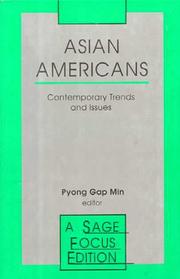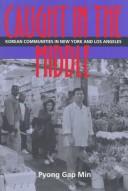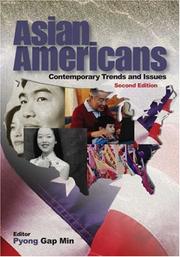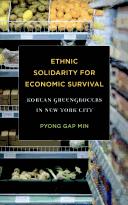| Listing 1 - 10 of 12 | << page >> |
Sort by
|

ISBN: 0803943369 Year: 1995 Volume: 174 Publisher: Thousand Oaks (Calif.): Sage
Abstract | Keywords | Export | Availability | Bookmark
 Loading...
Loading...Choose an application
- Reference Manager
- EndNote
- RefWorks (Direct export to RefWorks)
Amerikanen van Vietnamese origine --- Américains asiatiques --- Américains d'origine japonaise --- Américains d'origine vietnamienne --- Asian Americans --- Aziatische Amerikanen --- Cambodian Americans --- Chinese Americans --- East Indian Americans --- Filipino Americans --- Japanese Americans --- Japanse Amerikanen --- Korean Americans --- Laotian Americans --- Vietnamese Americans --- #KVHA:Volkeren; Verenigde Staten --- #KVHA:American Studies --- Chinese Amerikanen --- Sino-Américains --- Asians --- Ethnology
Book
ISBN: 0814759580 081479615X 9780814796153 9780814759585 9780814795859 0814795854 9780814795866 0814795862 Year: 2010 Publisher: New York, NY
Abstract | Keywords | Export | Availability | Bookmark
 Loading...
Loading...Choose an application
- Reference Manager
- EndNote
- RefWorks (Direct export to RefWorks)
Preserving Ethnicity through Religion in America explores the factors that may lead to greater success in ethnic preservation. Pyong Gap Min compares Indian Americans and Korean Americans, two of the most significant ethnic groups in New York, and examines the different ways in which they preserve their ethnicity through their faith. Does someone feel more “Indian” because they practice Hinduism? Does membership in a Korean Protestant church aid in maintaining ties to Korean culture?Pushing beyond sociological research on religion and ethnicity which has tended to focus on whites or on a single immigrant group or on a single generation, Min also takes actual religious practice and theology seriously, rather than gauging religiosity based primarily on belonging to a congregation. Fascinating and provocative voices of informants from two generations combine with telephone survey data to help readers understand overall patterns of religious practices for each group under consideration. Preserving Ethnicity through Religion in America is remarkable in its scope, its theoretical significance, and its methodological sophistication.
Minorities --- Emigration and immigration --- Immigrants --- Identification (Religion) --- Ethnicity --- Ethnic minorities --- Foreign population --- Minority groups --- Persons --- Assimilation (Sociology) --- Discrimination --- Ethnic relations --- Majorities --- Plebiscite --- Race relations --- Segregation --- Identity (Religion) --- Religious identity --- Psychology, Religious --- Emigrants --- Foreign-born population --- Foreigners --- Migrants --- Aliens --- Religious life. --- Religious aspects. --- Religious life

ISBN: 0520917693 0585053537 9780520917699 9780585053530 0520204883 0520204891 Year: 1997 Publisher: Berkeley, CA : University of California Press,
Abstract | Keywords | Export | Availability | Bookmark
 Loading...
Loading...Choose an application
- Reference Manager
- EndNote
- RefWorks (Direct export to RefWorks)
In this unflinching exploration of one of the most politically charged topics of our time, Pyong Gap Min investigates the racial dynamics that exist between Korean merchants, the African American community, and white society in general. Focusing on hostility toward Korean merchants in New York and Los Angeles, Min explains how the "middleman" economic role Koreans often occupy-between low-income, minority customers on the one hand and large corporate suppliers on the other-leads to conflicts with other groups. Further, Min shows how ethnic conflicts strengthen ties within Korean communities as Koreans organize to protect themselves and their businesses.Min scrutinizes the targeting of Korean businesses during the 1992 Los Angeles riots and the 1990 African American boycotts of Korean stores in Brooklyn. He explores Korean merchants' relationships with each other as well as with Latin American employees, Jewish suppliers and landlords, and government agencies. In each case, his nuanced analysis reveals how Korean communities respond to general scapegoating through collective action, political mobilization, and other strategies.Fluent in Korean, Min draws from previously unutilized sources, including Korean American newspapers and in-depth interviews with immigrants. His findings belie the media's sensationalistic coverage of African American-Korean conflicts. Instead, Caught in the Middle yields a sophisticated and clear-sighted understanding of the lives and challenges of immigrant merchants in America.
Korean Americans --- Korean American business enterprises --- Business enterprises, Korean American --- Korean American-owned business enterprises --- Business enterprises --- Ethnology --- Koreans --- New York (N.Y.) --- Los Angeles (Calif.) --- Race relations. --- E-books --- Minority Business Enterprises --- Social Science --- Business & Economics --- California --- Los Angeles. --- New York (State) --- New York.

ISBN: 1506319246 1452233802 1412905559 1452264473 9781452264479 9781452264479 9781452233802 1412905567 9781412905565 Year: 2006 Publisher: Thousand Oaks, Calif. Pine Forge Press
Abstract | Keywords | Export | Availability | Bookmark
 Loading...
Loading...Choose an application
- Reference Manager
- EndNote
- RefWorks (Direct export to RefWorks)
'Asian Americans' adopts the unique approach of examining the issues, and often obstacles, specific to Asian immigrants into the United States, such as occupational and economic adjustment intermarriage and settlement patterns.
Asian Americans --- Asian Americans. --- Asians --- Ethnology --- Social conditions.
Book
ISBN: 197881500X 1978814976 Year: 2021 Publisher: New Brunswick, New Jersey : Rutgers University Press,
Abstract | Keywords | Export | Availability | Bookmark
 Loading...
Loading...Choose an application
- Reference Manager
- EndNote
- RefWorks (Direct export to RefWorks)
Arguably the most brutal crime committed by the Japanese military during the Asia-Pacific war was the forced mobilization of 50,000 to 200,000 Asian women to military brothels to sexually serve Japanese soldiers. The majority of these women died, unable to survive the ordeal. Those survivors who came back home kept silent about their brutal experiences for about fifty years. In the late 1980s, the women’s movement in South Korea helped start the redress movement for the victims, encouraging many survivors to come forward to tell what happened to them. With these testimonies, the redress movement gained strong support from the UN, the United States, and other Western countries. Korean “Comfort Women” synthesizes the previous major findings about Japanese military sexual slavery and legal recommendations, and provides new findings about the issues “comfort women” faced for an English-language audience. It also examines the transnational redress movement, revealing that the Japanese government has tried to conceal the crime of sexual slavery and to resolve the women’s human rights issue with diplomacy and economic power.
World War, 1939-1945 --- Women and war --- Women --- Comfort women --- Sexual abuse victims --- Service, Compulsory non-military --- Reparations for historical injustices. --- Atrocities --- Crimes against --- History. --- Genocide, Politics, Political Violence, Human Rights, Gender Role, Military, Movements, Korea, Brutality, Sexual Slavery, Redress Movement, U.S., Immigrants, Victims, Exploitation, Japan, Torture, brothels, War crimes.

ISBN: 9780871545770 Year: 2008 Publisher: New York (N.Y.) : Russell Sage Foundation,
Abstract | Keywords | Export | Availability | Bookmark
 Loading...
Loading...Choose an application
- Reference Manager
- EndNote
- RefWorks (Direct export to RefWorks)
Korean American business enterprises --- Korean American businesspeople --- Korean Americans --- New York (N.Y.) --- New York (N.Y.) --- Ethnic relations. --- Emigration and immigration.
Book
ISBN: 0739178148 9780739178140 9780739178133 9780739178140 9780739187128 0739187120 073917813X Year: 2013 Publisher: Lanham Lexington Books
Abstract | Keywords | Export | Availability | Bookmark
 Loading...
Loading...Choose an application
- Reference Manager
- EndNote
- RefWorks (Direct export to RefWorks)
Koreans in North America covers various topics related to Korean experiences in the U.S. and Canada, including their immigration and settlement patterns, changes in business patterns, and identity, comprehensively. It also focuses on Korean Americans' twenty-first century experiences, using both quantitative and qualitative data.
Korean Americans --- Koreans --- History. --- United States --- Canada --- Korea --- Emigration and immigration.
Book
ISBN: 1978814984 9781978814981 9781978814974 1978814976 9781978814967 1978814968 9781978815001 197881500X Year: 2021 Publisher: New Brunswick
Abstract | Keywords | Export | Availability | Bookmark
 Loading...
Loading...Choose an application
- Reference Manager
- EndNote
- RefWorks (Direct export to RefWorks)
Examining both the 'comfort women' issue and the redress movement for the victims of Japanese military sexual slavery, this title shows the inadequacies of the claims by Japanese neo-nationalists and some scholars that the 'comfort women' system was not much different from or had some similarities to commercial prostitution.
World History --- History --- World history
Book
ISBN: 9781978815001 Year: 2021 Publisher: New Brunswick, NJ
Abstract | Keywords | Export | Availability | Bookmark
 Loading...
Loading...Choose an application
- Reference Manager
- EndNote
- RefWorks (Direct export to RefWorks)
Book
ISBN: 3110639874 3110643480 Year: 2020 Publisher: De Gruyter
Abstract | Keywords | Export | Availability | Bookmark
 Loading...
Loading...Choose an application
- Reference Manager
- EndNote
- RefWorks (Direct export to RefWorks)
This book examines the redress movement for the victims of Japanese military sexual slavery in South Korea, Japan, and the U.S. comprehensively. The Japanese military forcefully mobilized about 80,000-200,000 Asian women to Japanese military brothels and forced them into sexual slavery during the Asian-Pacific War (1932-1945). Korean "comfort women" are believed to have been the largest group because of Korea’s colonial status. The redress movement for the victims started in South Korea in the late 1980s. The emergence of Korean "comfort women" to society to tell the truth beginning in 1991 and the discovery of Japanese historical documents, proving the responsibility of the Japanese military for establishing and operating military brothels by a Japanese historian in 1992 accelerated the redress movement for the victims. The movement has received strong support from UN human rights bodies, the U.S. and other Western countries. It has also greatly contributed to raising people’s consciousness of sexual violence against women at war. However, the Japanese government has not made a sincere apology and compensation to the victims to bring justice to the victims.
| Listing 1 - 10 of 12 | << page >> |
Sort by
|

 Search
Search Feedback
Feedback About UniCat
About UniCat  Help
Help News
News